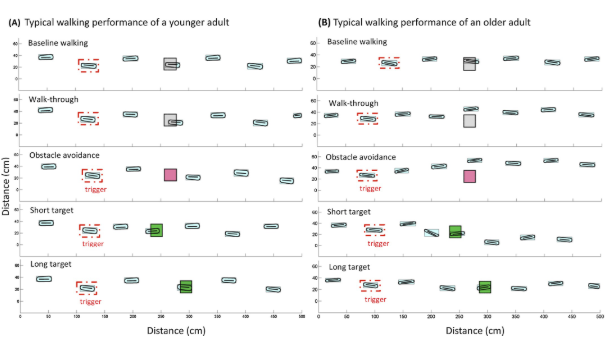Being able to adjust our walking pattern is crucial when performing daily living activities such as crossing a busy street or avoiding obstacles. Poor walking performance might contribute to tripping, which is a frequently reported cause of falls in older people. We recently devised a walking task that is able to assess an individual’s ability to adapt to environmental hazards. This new test requires people to either step onto a target or avoid an obstacle appearing on the pathway just before they reach it (i.e. two steps ahead). Our aim was to compare the adaptive walking strategies of young and older adults when performing this task.
Fifty healthy older adults and 21 young adults initially walked over an obstacle-free path (baseline walking). They then completed the following randomly presented adaptive walking trials: obstacle avoidance, short stepping target, long stepping target and no target/obstacle (walk-through) trials (see figure for details). Older adults adopted a more cautious walking strategy, which was characterized by slower gait speed, shorter step length and a longer time spent in double support when they approached the targets/obstacle. However, despite this cautious strategy, older adults made more mistakes (failed to hit the stepping targets and/or to avoid the obstacle) and were less accurate to step on the centre of the target than young adults. In addition, young individuals maintained the same walking pattern for both the baseline and walk-through conditions, whereas older participants reduced their step length and gait speed and increased their double-support time significantly in the walk-through condition.
The older adults adopted a conservative walking pattern throughout the experiment, even when a target/obstacle was not presented (walk-through condition). Older adults might therefore be more affected by the possibility of a hazard appearing on the pathway than young adults. The same conservative walking strategy was also detected for each target/obstacle condition in the older group. However, despite this strategy, older adults still had a poorer stepping accuracy and made more mistakes. This reduced ability to adjust walking performance when needed may place older adults at increased risk of falling when unexpected hazards appear, such as a suddenly noticed crack in the pavement. Our findings may contribute to the development of new strategies for improving adaptive walking performance in the older population and may assist the efficacy of fall prevention programmes. New strategies could include the decision-making component and/or obstacle avoidance/stepping target training while walking. Future studies should investigate whether our test paradigm can predict future falls, and also whether walking adaptability training can improve both task performance and prevent future falls.

Figure. Typical walking performance of a younger adult (A) and an older adult (B) for each condition (baseline, walk-through, obstacle avoidance, short target and long target. Obstacle position is showed in the baseline and walk-through conditions as a representation of its location. No stimulus was triggered for those conditions. The target/obstacle appearance was triggered on the heel strike of the footfall indicated by the dashed red boxes.
Publication
Caetano MJD, Lord SR, Schoene D, Pelicioni PHS, Sturnieks DL, Menant JC. Age-related changes in gait adaptability in response to unpredictable obstacles and stepping targets. Gait Posture 2016; 46:35-41. http://www.gaitposture.com/article/S0966-6362(16)00044-8/abstract
About the Author

Maria Joana Duarte Caetano
Falls, Balance and Injury Research Centre, Neuroscience Research Australia, University of New South Wales
Maria Joana Duarte Caetano is a PhD candidate at the Falls, Balance and Injury Research Centre, Neuroscience Research Australia, University of New South Wales, Sydney, Australia.
Joana’s research aims to understand how older people adapt their gait in face of challenging environment and identify associated cognitive-motor factors. Further, she investigates the effectiveness of a videogame step training on improving gait adaptability performance in people with Parkinson’s disease. The study presented here is part of her doctoral work supported by the Conselho Nacional de Desenvolvimento Científico e Tecnológico.
Copyright
© 2018 by the author. Except as otherwise noted, the ISPGR blog, including its text and figures, is licensed under a Creative Commons Attribution-ShareAlike 4.0 International License. To view a copy of this license, visit https://creativecommons.org/licenses/by-sa/4.0/legalcode.
ISPGR blog (ISSN 2561-4703)
Are you interested in writing a blog post for the ISPGR website? If so, please email the ISGPR Secretariat with the following information:
- First and Last Name
- Institution/Affiliation
- Paper you will be referencing
